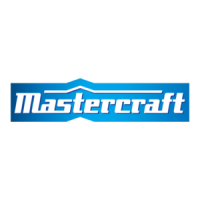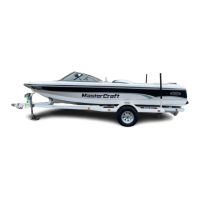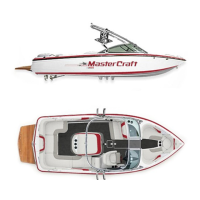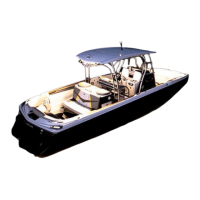Do you have a question about the MasterCraft 1999 MariStar 210 and is the answer not in the manual?
| Year | 1999 |
|---|---|
| Make | MasterCraft |
| Model | MariStar 210 |
| Length | 21 ft |
| Weight | 2, 800 lbs |
| Fuel Capacity | 35 gallons |
| Horsepower | 310 hp |
| Seating Capacity | 10 |
| Engine | V8 |
| Draft | 22 inches |
Details on the standard features and amenities included with MasterCraft boats.
Information on NMMA certification and serial number locations.
Details on identifying engine and trailer serial and model numbers.
Outlines basic safety rules, precautions, and hazard symbols.
Lists safety information sources and required equipment.
Suggests additional equipment for safe boating and trip enjoyment.
General safety for operating on water and specific guidelines for water skiing.
Covers waterway rules, sound signals, and vessel right-of-way.
Explains 'stand-on' and 'give-way' vessel concepts and collision avoidance.
Guidelines for navigating narrow channels and bends.
Discusses right-of-way for vessels and how to read navigation aids.
Explanation of speedometer, tachometer, and engine hourmeter functions.
Details the voltmeter, fuel gauge, and engine temperature gauge.
Explains engine oil pressure gauge and the 'Check Engine' light.
Operation of the ignition switch and emergency safety switch.
Operation of horn, navigation lights, and blower switches.
Information on circuit breaker locations and ratings.
Describes steering wheel operation and the shift/throttle control.
Operation of interior lights, clock, and speedometer calibration.
Details the boat's fuel system, including components and operation.
Discusses the use of alcohol-blended fuels and additives.
Checklist of safety items to verify before and during boat operation.
Specific procedures for the initial 15 hours of the boat's operation.
Guidelines for operation after the initial break-in period.
Pre-start checks and familiarization with controls and indicators.
Step-by-step instructions for starting the boat's engine.
Procedures for shifting gears, operating underway, and stopping the boat.
General operational principles and guidance on proper boat loading.
Guidelines for first-time operators and basic boat maneuvering techniques.
Considerations for high speeds and unusual operating conditions.
Information on properly using a storage cradle for the boat.
Explains galvanic corrosion and salt water effects on the boat.
Details maintenance tasks for different intervals (e.g., every use, quarterly, annually).
Maintenance tasks recommended every 50 and 100 hours.
Procedures for checking engine oil, transmission fluid, and coolant levels.
Inspect engine belts for tension and service fuel filters.
Check engine hardware and inspect throttle/shift cables.
Check battery terminals and hold-downs for security and corrosion.
Check exhaust system for leaks and propeller shaft log for water entry.
Inspect fuel system for leaks and perform engine oil change.
Lubricate the starter gear and shaft.
Annual tasks: clean flame arrestor, engine tune-up, and transmission fluid change.
Check coupling alignment and lubricate steering system.
Lubricate shift and throttle cables.
Inspect exhaust flaps, engine mounts, and fuel system for leaks.
Step-by-step guide for changing boat propellers.
Procedure for checking propeller damage and making minor repairs.
Instructions for calibrating the boat's speedometer.
Instructions for replacing boat lights and fuses.
Procedures for preparing the boat for storage while in the water.
Steps to prepare the boat for use after storage.
Common causes and solutions for engine starting issues.
Troubleshooting for engines that run rough or miss.
Diagnosing and resolving issues related to poor boat performance.
Troubleshooting poor gas mileage, controls, and vibration.
Troubleshooting common electrical issues.
Resolving issues with speedometer readings.
Detailed specifications for the MasterCraft Corvette engine.
Detailed specifications for the MasterCraft Vortex engine.
Details on optional Power Slot Package and fresh water cooling system.
Lists various additional options available for the boat.
Information on dealer services and warranty registration procedures.
Procedures for warranty claims and owner obligations.
Recommendations for boat insurance and registration.
Guidelines for maintenance, passenger briefing, courtesy, and storage.
Explanation of warranty coverage periods, components, and exclusions.
Introduction to trailerizing and launching MasterCraft trailers.
Pre-towing checklist for the trailer.
Ensuring proper trailer match, load capacity, and weight distribution.
Details on types of trailer hitches and proper installation.
Importance of safety cables and operation of the winch assembly.
Warning regarding hinged tongues and proper trailer coupling.
Ensuring trailer lights are functional and maintaining wheels/hubs.
Checking lug nuts, lubricating bearings, and tire maintenance.
Maintenance of trailer brakes and proper use of the trailer jack.
Ensuring secure tie-downs and proper hitching to the tow vehicle.
Tips for safe and effective trailer towing.
Guidance on safely launching the boat from the trailer.
Procedures for storing the trailer and boat during the off-season.
General tips for trailer maintenance and use.
Steps for registering the boat's warranty.
Information and procedure for transferring the boat's warranty.











